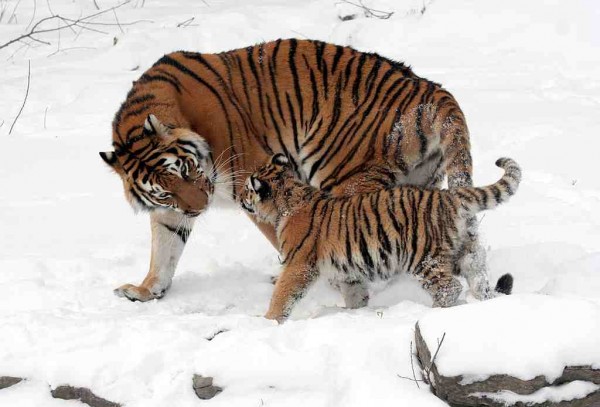Half the World's Wildlife is Gone, Says New Data
| Ana Verayo | | Oct 01, 2014 08:21 AM EDT |
(Photo : Dave Pape/Wikipedia) Siberian tiger populations on the decline even after a decade of conservation efforts, according to a 2005 survey
World wildlife populations have fallen by half since the 1970s, according to the London Zoological Society.
Mammals, birds reptiles, amphibians actually have worse population numbers than previously thought. Their numbers dropped a whopping 52 percent. Freshwater fish fared worse with their numbers plunging by an alarming 76 percent, said the society.
Like Us on Facebook
A new method used to measure wildlife populations has proven to be more accurate compared to past reports, said a new report in the society's Living Planet Index. The index tracked more than 10,000 vertebrate species populations from 1970 to 2010.
It reveals a non-stop drop in these animal populations and this global trend isn't slowing down.
Under the new weighted method, arriving at an accurate picture of the rate of population decline for species in that region has to compare two species.
If most measurements in a region are of bird populations, but the greatest actual number of vertebrates in the region are fish, it's necessary to give a greater weight to measurements of fish populations.
After applying this new method to the 2008 data, scientists discovered that wildlife populations had significantly worse numbers. More ominously, this is becoming a trend applicable to all species.
The main cause of this decline in species populations is due to habitat and environment destruction and human disturbance.
According to Stephen Buckland from the National Center for Statistical Ecology in the UK, tropical areas are the hardest hit in this population decline despite their rich biodiversity as opposed to temperate areas.
This population drop has been a disturbing phenomenon for decades with local governments and authorities, including global environmental agencies, finding it difficult to scan these areas.
Hence, this study recommends monitoring areas where species decline is most prevalent, areas where most human interference is widespread.
TagsHalf of the World's Wildlife Populations Has Been Wiped Out Since the 1970s, wildlife populations decline cut in half, living planet index, world wildlife populations cut in half decreased 50 percent
©2015 Chinatopix All rights reserved. Do not reproduce without permission
EDITOR'S PICKS
-

Did the Trump administration just announce plans for a trade war with ‘hostile’ China and Russia?
-

US Senate passes Taiwan travel bill slammed by China
-

As Yan Sihong’s family grieves, here are other Chinese students who went missing abroad. Some have never been found
-

Beijing blasts Western critics who ‘smear China’ with the term sharp power
-

China Envoy Seeks to Defuse Tensions With U.S. as a Trade War Brews
-

Singapore's Deputy PM Provides Bitcoin Vote of Confidence Amid China's Blanket Bans
-

China warns investors over risks in overseas virtual currency trading
-

Chinese government most trustworthy: survey
-

Kashima Antlers On Course For Back-To-Back Titles
MOST POPULAR
LATEST NEWS
Zhou Yongkang: China's Former Security Chief Sentenced to Life in Prison

China's former Chief of the Ministry of Public Security, Zhou Yongkang, has been given a life sentence after he was found guilty of abusing his office, bribery and deliberately ... Full Article
TRENDING STORY

China Pork Prices Expected to Stabilize As The Supplies Recover

Elephone P9000 Smartphone is now on Sale on Amazon India

There's a Big Chance Cliffhangers Won't Still Be Resolved When Grey's Anatomy Season 13 Returns

Supreme Court Ruled on Samsung vs Apple Dispute for Patent Infringement

Microsoft Surface Pro 5 Rumors and Release Date: What is the Latest?










